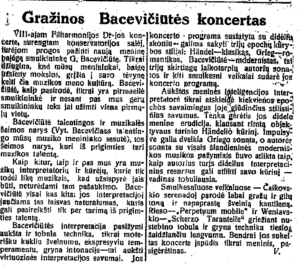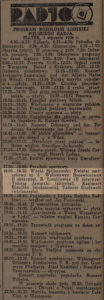Dear Vitek, I’m writing, because I have something to ask and I apologise for the trouble. Imagine that there are still no decent strings in Europe. I’m sending you the same dollars you once sent me and I beg you – buy me Thomastik G and D strings. These are not very expensive strings and they’ll be good for my violin. The G string, although lower than D, must be thinner. I always prefer thinner strings to thicker ones. They are, of course, metal strings. Once again, apologies for the trouble. I will repay you for your kindness at the wedding. I’ll soon write to you about my projects and plans – lots of love for now. Gr.
Paris 9e Adelphi-Hotel 4, rue Taibout, 3 March 1947
In the first few years after the war Grażyna sent similar requests to her brother several times. Europe was slowly rising from the ruins, trying to satisfy the most urgent needs. Good strings in music stores were not among them, although concert life was revived very quickly and the already well-known violinist from Poland was a welcome guest at increasingly numerous concerts. Many reviews of Grażyna Bacewicz’s performances all over Europe have survived, although we should bear in mind that her successes were due not only to her talent and hard work, but also care for her instrument. This care was evident already at the beginning of her career, as she looked for instruments thanks to which her interpretation would be “characterised by excellent technique, truly feminine delicacy, expressive temperament, clear intonation – qualities typical of a virtuoso interpretation,” wrote the reviewer of the Lithuanian newspaper Rytason 24 April 1930 after one of Grażyna’s concerts in Kaunas.
- Press note on Grażyna Bacewicz’s concert in Lithuania (Rytas, 1930)
When still a student at the Helena Kijeńska-Dobkiewiczowa Conservatory, Grażyna appeared both as a violinist and as a pianist. For example, at the annual Conservatory student concert in 1927, which took place at the Łódź Philharmonic Hall, she performed Mendelssohn’s Piano Concerto in G minor with orchestra. As late as in 1953, on 17 December, she premiered her Piano Sonata No. 2, not an easy piece by any means, at a Polish Composers’ Union concert. However, these were just incidents in her career as a violinist, which was launched in the 1930s with several performances in Lithuania. After the 1930 tour Grażyna returned to her father’s homeland in 1932. She once again received enthusiastic reviews, with critics also pointing to the specificity of her playing. On 19 September 1932 the Kaunas-based newspaper Rytas reported in the article “Gražinos Bacevičiútes koncertas” that
Grażyna Bacewicz is a modernist par excellence. If anybody expected to hear a fabulously delicate tone, charming, warm, emotional nuances – they may have been slightly disappointed. She gave a vivid, fiery performance, with no hint of romantic plaintiveness – cool – without any sentimentalism. Her temperament is vivid, ‘honest’, her orientation quick, her movements resolute.
During her recitals Grażyna performed both her own pieces and the usual repertoire comprising popular works by great composers or numerous transcriptions. During her visit to Paris in 1947 Guide du Concert of 23 May reported that
Grażyna Bacewicz has a solid technique and a feel for rhythmic nuances. She knows how to display the entirety of a musical phrase and complexity of sound planes. She sails through Paganini’s diabolical acrobatic feats with ease. The performance culminated with her delicate interpretation of Ravel’s ‘Pastourelle’, a piece that was encored.
For many years Grażyna Bacewicz was the first performer of her violin works – both chamber pieces and concertos. It was not until Violin Concerto No. 5, composed in 1954, that she entrusted a work of hers to someone else, Wanda Wiłkomirska, in this case. In addition, her repertoire was indeed vast. Apart from her own works, she played concertos by Mozart, Mendelssohn, Tchaikovsky, Prokofiev, Khachaturian, Kabalevsky as well as Introduction and Rondo capriccioso by Saint-Saëns, Spanish Symphonyby Lalo; among the sonatas: Tartini’s Le trille du diable, Handel’s Sonata in D major, Grieg’s sonatas, Ravel’s Tziganeand many other pieces.
However, solo career was not the only form of her activity as a violin virtuoso. Persuaded by Grzegorz Fitelberg, in 1935 she joined his Polish Radio Orchestra for two and a half years, sitting in the first violin section. What she obviously had in mind were the befits of working in an orchestra for her as the composer of future works for symphonic line-ups. Getting to know the complex orchestral apparatus certainly enabled her to expand her knowledge of instrumentation. As a matter of fact, during her stint in the orchestra he composed three works performed by her ensemble. The first was Simfonietta (the composer’s original spelling) for string orchestra written in 1935 and premiered the following year; next came Three Songsto Arabic poems translated by Leopold Staff, also existing in a version for voice and piano, premiered in 1938; finally Violin Concerto No. 1 from 1937, which the composer performed as the soloist with her orchestra in 1938.
Persuaded by Feliks Roderyk Łabuński, who in 1934–1936 served as the Head of Classical Music at the Polish Radio, Grażyna agreed to become the principal of a string quartet featuring the orchestra’s musicians – Bogdan Łosakiewicz as the second violin, Bolesław Jaworski on the viola and Kazimierz Blaschke on the cello.
- Announcement of a concert by Bacewicz’s quartet in the Polish Radion programme (Ilustrowana Republika, 1936)
A beautiful testimony to her skills as a violinist was provided by her “fellow string” Eugenia Umińska:
Bacewicz had this incredible technical ease of playing, assurance and agility in both hands (she was an excellent representative of Prof Jarzębski’s school), reliably strong fingers, crystal clear intonation, robust and supple rhythm, unshakeable organisation of interpretation and memory.
Eugenia Umińska, ‘Wspomnienie [o Grażynie Bacewicz’, Ruch Muzyczny, 1969 no. 7, p. 9.
Elsewhere in the article the violinist adds:
When Grażyna returned from Paris after a few months (after the war), she said to me, slightly mockingly, ‘You know, it seems I’m going to have a career as a violinist! I played Szymanowski’s Concerto No. 1 with Paul Kletzki in Paris. A very pleasant experience it was, but I want to write above all!’ I can’t remember when, after a concert in Kraków, I think, Grażyna once said, ‘I’m through with playing the violin, it’s too much for my nerves! If I do continue to play, it’ll be only my own music.’ And this is what happened.

